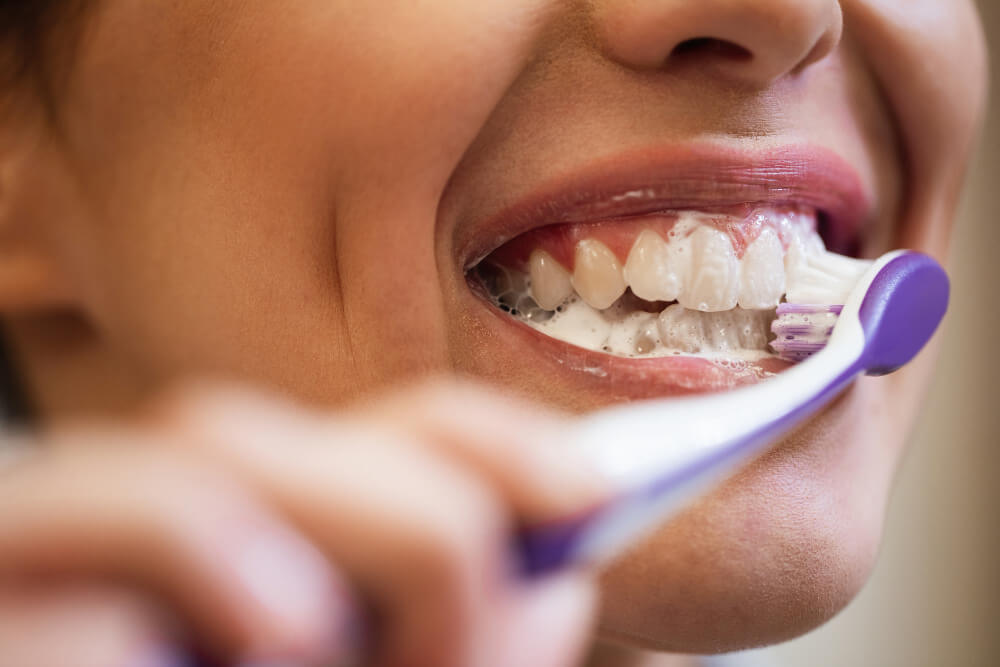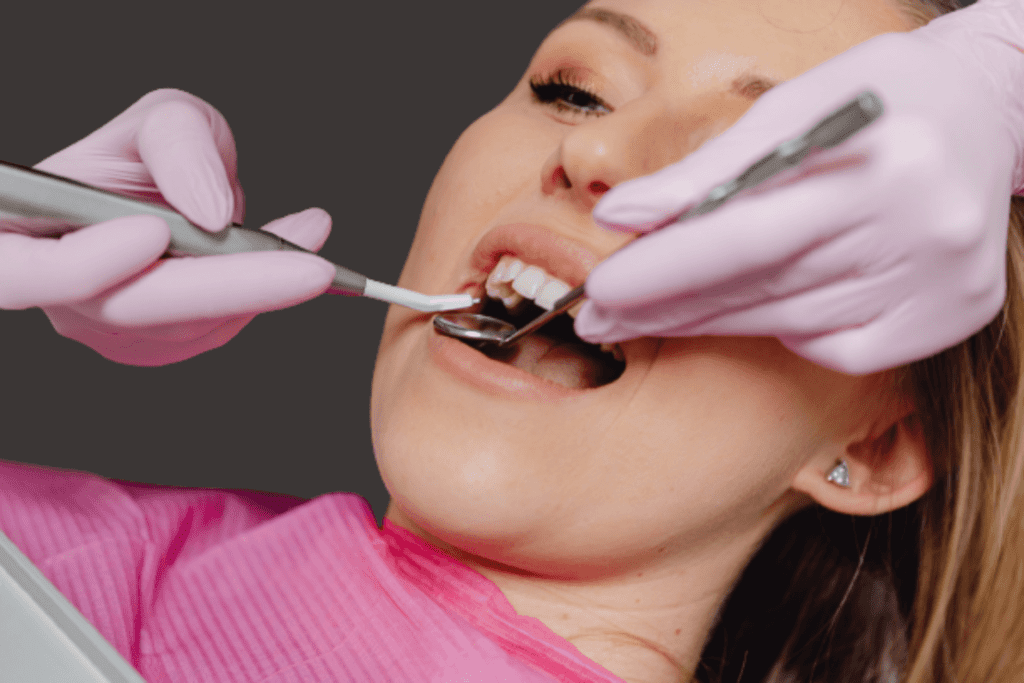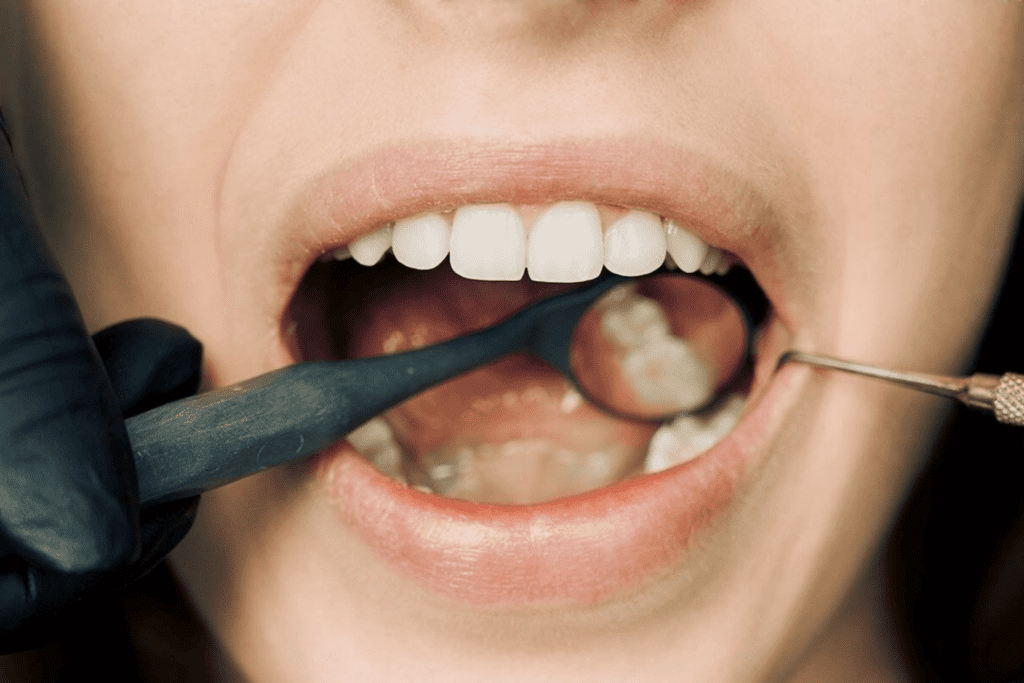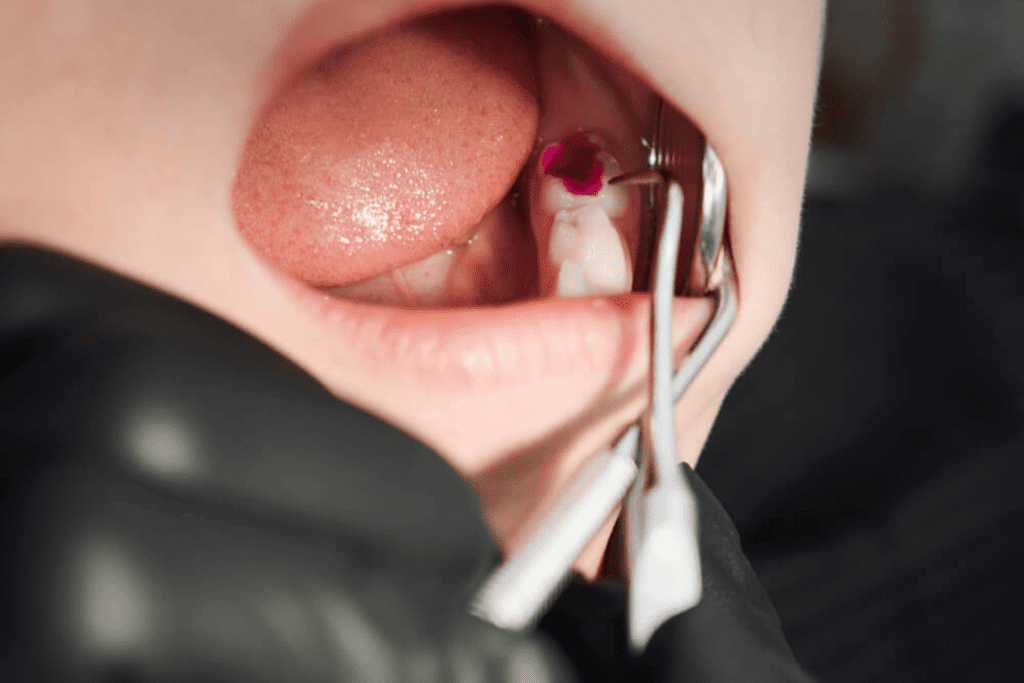We sometimes add products that we believe may be beneficial to our readers. We may receive a small commission if you purchase using the links on this page. Read our affiliate disclaimer
Dentin hypersensitivity, also referred to as tooth sensitivity, is a prevalent dental ailment characterized by brief, intense pain or discomfort triggered by specific stimuli. It occurs when the underlying layer of tooth structure called dentin becomes exposed. Dentin contains tiny tubules that lead to the nerve endings within the tooth, and when exposed, these tubules allow external stimuli such as hot, cold, sweet, or acidic substances to reach the nerve, causing sensitivity
Table of Contents
ToggleDentin Hypersensitivity Symptoms
Dentin hypersensitivity, or tooth sensitivity, can manifest with various symptoms. The most common symptoms include:

Sharp Pain or Discomfort
Dentin hypersensitivity often presents as a sudden, sharp pain or discomfort. This pain can be intense and occur in response to specific triggers like consuming hot, cold, sweet, or acidic foods and beverages. The pain may be brief but can be quite uncomfortable.
Sensitivity to Temperature
Teeth affected by dentin hypersensitivity can be particularly sensitive to temperature changes. When exposed to hot or cold substances, such as hot coffee or ice cream, the affected tooth may quickly respond with sharp pain or sensitivity.
Sensitivity to Touch
Individuals with dentin hypersensitivity may experience sensitivity when the affected tooth is touched or when pressure is applied. This sensitivity can make activities like brushing, flossing, or even biting into certain foods uncomfortable or painful.
Discomfort During Brushing
Brushing the teeth can become an uncomfortable experience for those with dentin hypersensitivity. Using a toothbrush with firm bristles or applying excessive pressure while brushing can trigger pain or sensitivity in the affected teeth.
Gum Sensitivity
Dentin hypersensitivity can also affect the gums surrounding the sensitive teeth. The gums may become tender or sensitive, causing discomfort or pain when brushing or flossing. This sensitivity can further exacerbate the discomfort associated with dentin hypersensitivity.
Causes of Sensitive Teeth
Sensitive teeth, or dentin hypersensitivity, can be caused by various factors. Some common causes include:

Gum Recession
When gums recede, the underlying root surfaces of the teeth become exposed. Since the roots do not have a protective layer of enamel, the dentin underneath can be easily stimulated by hot, cold, or acidic substances, leading to tooth sensitivity.
Enamel Erosion
Enamel erosion occurs when the hard outer layer of the tooth enamel gradually wears away. This can be caused by consuming highly acidic foods and drinks, such as citrus fruits, soda, or sports drinks. Additionally, aggressive tooth brushing or using a toothbrush with hard bristles can contribute to enamel erosion. As enamel thins, the dentin layer becomes more exposed and susceptible to sensitivity.
Tooth Decay
When tooth decay progresses and reaches the inner layers of the tooth, it can lead to sensitivity. The decay destroys the protective enamel, exposing the dentin and allowing external stimuli to reach the nerves within the tooth, resulting in sensitivity and discomfort.
Tooth Grinding
Bruxism, or tooth grinding and clenching, can wear down the enamel over time. This excessive pressure and friction can eventually expose the dentin, causing tooth sensitivity.
Dental Procedures
Certain dental treatments can cause temporary sensitivity. Teeth whitening procedures, for example, can temporarily increase tooth sensitivity, but it typically subsides after treatment. Dental fillings or adjustments made during orthodontic treatment can also cause sensitivity, which usually resolves over time.
Cracked or Fractured Teeth
Cracks or fractures in the teeth can expose the dentin and lead to sensitivity. These cracks can occur due to various factors, such as trauma, biting into hard objects, or tooth grinding.
Overzealous Brushing
Brushing the teeth too aggressively or using a toothbrush with hard bristles can wear down the enamel and irritate the gums. This can result in gum recession and enamel erosion, contributing to tooth sensitivity.
Acidic Diet
Regular consumption of acidic foods and beverages can gradually erode the enamel. The acid weakens the protective layer, making the dentin more vulnerable to stimulation and resulting in tooth sensitivity.
Age-Related Factors
As individuals age, the gums naturally recede to some extent, exposing more of the tooth surface near the gumline. Additionally, the enamel may naturally wear down over time, making the dentin more susceptible to sensitivity.
Diagnosis of Tooth Sensitivity
The diagnosis of tooth sensitivity typically involves a dental professional evaluating your symptoms, conducting a thorough examination, and sometimes performing additional tests. Here is an overview of the diagnostic process for tooth sensitivity:

Dental History
Your dentist will ask you questions about your dental history and the symptoms you have been experiencing. They will inquire about the nature of the sensitivity when it started, and any specific triggers that worsen the discomfort. This helps provide valuable information about the duration and characteristics of the sensitivity.
Visual Examination
The dentist will visually examine your teeth and gums. They will look for any visible signs of dental problems such as decay, gum recession, enamel erosion, or cracks in the teeth. They may also evaluate the condition of dental restorations, such as fillings or crowns, as these can contribute to tooth sensitivity if they are damaged or ill-fitting.
Probing
Using a dental instrument called a periodontal probe, the dentist may gently explore the teeth and gums. This probing helps identify areas of tenderness or sensitivity and assists in locating the specific teeth or regions that are causing the discomfort.
X-rays
X-rays, also known as dental radiographs, may be taken to assess the underlying structures of the teeth. X-rays can reveal any signs of tooth decay, infections, bone loss, or abnormalities that may be associated with tooth sensitivity.
Air/Water Sensitivity Test
The dentist may use a gentle stream of air or water on the teeth to assess your sensitivity response. By directing air or water on specific teeth, the dentist can observe your reaction and determine the severity of sensitivity. This test helps pinpoint the affected areas and evaluate the response to different stimuli.
Thermal Sensitivity Test
In this test, the dentist applies hot or cold stimuli to the teeth and observes your response. This helps determine the temperature range that triggers sensitivity and aids in identifying the specific teeth involved. The dentist may use cotton swabs soaked in hot or cold water or specialized instruments to apply controlled temperature stimuli.
Bite Test
If there are indications of cracked or fractured teeth as a possible cause of sensitivity, a bite test may be performed. During this test, the dentist will apply pressure to the teeth while you bite down. This helps identify any abnormal movement, discomfort, or pain that can indicate cracked or fractured teeth.
Medical History Review
Your dentist may inquire about your medical history, including any underlying health conditions or medications you are taking. Certain systemic conditions or medications can contribute to tooth sensitivity, and understanding your medical history helps in evaluating potential factors contributing to your sensitivity.
How to Prevent Dental Hypersensitivity?
Preventing dental hypersensitivity involves adopting good oral hygiene practices and making lifestyle changes to protect your teeth and gums. Implementing preventive measures can help you proactively address tooth sensitivity.
Maintain Proper Oral Hygiene

Brushing your teeth at least twice a day is essential for preventing dental hypersensitivity. Use a soft-bristled toothbrush and fluoride toothpaste. Brush gently using circular motions to clean your teeth effectively without causing enamel wear or gum irritation.
Use Desensitizing Toothpaste
Desensitizing toothpaste is specifically formulated to reduce tooth sensitivity. These toothpaste contain ingredients like potassium nitrate or stannous fluoride, which help block the nerve signals that cause sensitivity. Use the toothpaste as directed by your dentist to experience its full benefits over time.
Choose a Soft-Bristled Toothbrush
Using a toothbrush with soft bristles is crucial for preventing enamel wear and gum damage. Soft bristles effectively clean your teeth without causing unnecessary abrasion. It is recommended to replace your toothbrush every three to four months, or earlier if the bristles start to fray.
Avoid Acidic Foods and Beverages
Acidic foods and drinks can erode the enamel and contribute to tooth sensitivity. Limit your consumption of citrus fruits, carbonated drinks, sports drinks, and vinegar-based products. If you do consume acidic substances, rinse your mouth with water afterward to help neutralize the acidity.
Use a Mouth Guard for Teeth Grinding
The habit of teeth grinding or clenching can contribute to enamel erosion and eventual tooth sensitivity. If you grind your teeth during sleep, wearing a custom-fitted mouth guard can provide a protective barrier and reduce the impact of grinding forces on your teeth.
Don't Brush Immediately After Consuming Acidic Substances
Acidic foods and drinks temporarily soften the enamel. Brushing immediately after can cause further enamel wear. Wait for at least 30 minutes before brushing your teeth to allow the enamel to remineralize and regain its strength.
Practice Proper Brushing Technique
Use gentle pressure and small, circular motions while brushing your teeth. Avoid brushing too aggressively or using a back-and-forth sawing motion, as it can damage the enamel and irritate the gums. Pay attention to all surfaces of the teeth, including the gum line.
Avoid Excessive Force During Flossing
Be gentle when flossing to avoid injuring the gums or causing sensitivity. Use a gentle back-and-forth motion and follow the natural curves of your teeth. Flossing helps remove plaque and debris from between the teeth, promoting gum health and preventing sensitivity.
Visit your Dentist Regularly
Regular dental check-ups are crucial for maintaining oral health and preventing dental hypersensitivity. Your dentist can identify early signs of sensitivity or underlying dental issues. They can provide professional cleanings, offer personalized advice, and recommend suitable treatments to address your specific needs.
Limit Teeth Whitening Treatments
Teeth whitening products or treatments can cause temporary tooth sensitivity. If you choose to whiten your teeth, consult with your dentist first. They can recommend appropriate whitening options and guide minimizing sensitivity during and after the process.
Treatments for Dentin Hypersensitivity
The treatment of dentin hypersensitivity aims to alleviate the symptoms and address the underlying causes. Here are some common treatments and approaches for managing dentin hypersensitivity:

Home Remedies
Home remedies can provide temporary relief for teeth sensitivity. Here are some common home remedies that can help alleviate the discomfort:
Saltwater Rinse:
Saltwater rinses are a common remedy for various oral issues due to their antimicrobial and anti-inflammatory properties. The warm saltwater solution helps reduce inflammation and can provide temporary relief from tooth sensitivity. Dissolve half a teaspoon of salt in eight ounces of warm water, swish it around your mouth for about 30 seconds, focusing on the sensitive area, and then spit it out. Repeat this process multiple times throughout the day or as necessary.
Clove Oil:
Clove oil contains eugenol, which acts as a natural analgesic and has been used for centuries to alleviate tooth pain. Apply a small amount of clove oil to a cotton ball and gently dab it on the affected tooth or gums. Allow it to remain for a few minutes before rinsing your mouth with water. Clove oil can help numb the area, reduce inflammation, and provide temporary relief from sensitivity.
Green Tea:
Green tea possesses anti-inflammatory properties and is rich in catechins, compounds that have the potential to reduce tooth sensitivity. To harness its benefits, prepare a cup of green tea and allow it to cool. Utilize it as a mouthwash, swishing it around your mouth for one to two minutes before spitting it out. Repeat this process several times a day. Green tea can offer relief by soothing irritated gums and potentially alleviating sensitivity.
Honey and Warm Water:
Honey has antimicrobial properties and can provide temporary relief from tooth sensitivity. Mix equal parts of honey and warm water to create a solution. Swish the solution around your mouth for a few minutes, focusing on the sensitive areas, and then spit it out. Honey can help reduce inflammation and provide a soothing effect.
Aloe Vera Gel:
Renowned for its soothing properties, aloe vera gel holds the potential to alleviate tooth sensitivity. Gently apply a small amount of pure aloe vera gel directly to the sensitive tooth or gums. Allow it to remain for a few minutes before rinsing your mouth with water. Aloe vera gel possesses anti-inflammatory properties, which can aid in reducing inflammation and soothing the affected area, potentially offering relief from tooth sensitivity.
Oil Pulling:
Oil pulling, an ancient Ayurvedic practice, aims to eliminate toxins and enhance oral health by swishing oil in the mouth. Take a tablespoon of coconut oil or sesame oil and swish it around your mouth for 15-20 minutes, ensuring to move it between your teeth. Afterward, expel the oil from your mouth and rinse thoroughly with water to cleanse your oral cavity. Oil pulling aids in the removal of bacteria, reduction of plaque buildup, and potential alleviation of tooth sensitivity with consistent practice over time.
Avoid Triggering Foods and Drinks:
It’s important to limit your consumption of foods and drinks that can trigger tooth sensitivity. Hot and cold foods, sugary foods, and acidic beverages can worsen sensitivity. Opt for lukewarm or room-temperature foods and drinks instead. Also, try to avoid excessive consumption of citrus fruits, sodas, sports drinks, and other acidic substances that can erode the enamel and contribute to sensitivity.
In-Office Treatments
In addition to at-home treatments, there are several in-office treatments available for dentin hypersensitivity that can provide immediate relief. Here are some common in-office treatments:
Professional Fluoride Application:
Your dentist will apply a highly concentrated fluoride gel, foam, or varnish to the sensitive teeth. The fluoride penetrates the enamel and helps strengthen it, promoting remineralization and reducing sensitivity. The application is typically done using trays, brushes, or swabs, and the fluoride is left on the teeth for a specific period to maximize its effectiveness.
Dental Bonding:
Dental bonding involves applying a tooth-colored resin material to the exposed dentin or root surfaces. The resin is carefully shaped and bonded to the tooth, creating a protective layer that covers the sensitive areas. Dental bonding not only reduces sensitivity but also helps improve the tooth’s appearance and can address minor cosmetic issues.
Dental Sealants:
Dental sealants are thin plastic coatings applied to the chewing surfaces of the back teeth, particularly the molars. While sealants are primarily used to prevent decay, they can also help reduce sensitivity. By sealing off the pits and fissures on the tooth surface, sealants create a barrier that protects the underlying dentin and reduces sensitivity caused by external stimuli.
Dentin Desensitizing Agents:
Dentin desensitizing agents are applied directly to the sensitive areas of the teeth. These agents typically contain compounds like oxalates, potassium salts, or calcium phosphate, which work by blocking nerve signals and reducing sensitivity. They can be in the form of varnishes, gels, or adhesive materials that are carefully applied to the affected teeth, providing immediate relief.
Laser Therapy:
Laser treatment can be used to desensitize and seal the exposed dentin. The laser energy is applied to the sensitive areas, stimulating the formation of a protective layer or sealing the tubules within the dentin. Laser therapy is a precise and minimally invasive approach that can provide immediate relief from sensitivity and promote healing.
Root Canal Treatment:
Root canal treatment is a more invasive option used when other treatments fail to alleviate sensitivity. It is typically reserved for severe cases where the sensitivity is caused by nerve damage or infection. During a root canal procedure, the dentist removes the infected or damaged pulp tissue, cleans the root canal system, and seals it. This eliminates the sensitivity by eliminating the source of the problem.
Conclusion
Tooth sensitivity, also known as dentin hypersensitivity, can significantly impact daily activities and oral health. It manifests as sharp tooth pain when exposed to specific triggers like temperature changes, sweet or acidic foods, or even brushing. Diagnosing the underlying cause is vital for effective treatment, and dentists employ various techniques such as examinations and X-rays to identify the root issue.
Preventing dentin hypersensitivity involves maintaining good oral hygiene practices, using desensitizing toothpaste, and avoiding habits that contribute to enamel wear or gum irritation. Limiting consumption of acidic foods and drinks and addressing teeth grinding with a mouthguard is also recommended.
Treatment options encompass both at-home and in-office approaches. At home, individuals can use desensitizing toothpaste, practice gentle brushing techniques, and make dietary adjustments. In-office treatments range from professional fluoride application and dental bonding to dental sealants, dentin desensitizing agents, laser therapy, and, in severe cases, root canal treatment
Consulting a dentist is crucial for a proper diagnosis and personalized treatment plan. Dentists can provide guidance, recommend suitable products, and perform in-office procedures to alleviate tooth sensitivity and improve oral health. Regular dental visits and proactive care are essential for maintaining a healthy, pain-free smile.
Resources
Image Designed by freepik
Reference
https://bmcoralhealth.biomedcentral.com/articles/10.1186/s12903-019-0781-x
https://www.ncbi.nlm.nih.gov/pmc/articles/PMC3010026/
https://link.springer.com/article/10.1007/s00784-012-0898-7
https://pubmed.ncbi.nlm.nih.gov/32762733/
https://bmcoralhealth.biomedcentral.com/articles/10.1186/s12903-020-01216-1
https://www.mdpi.com/2304-6767/7/1/5





